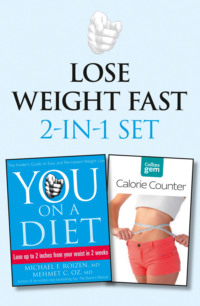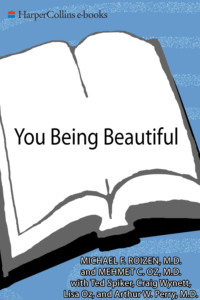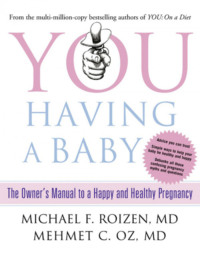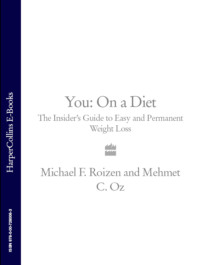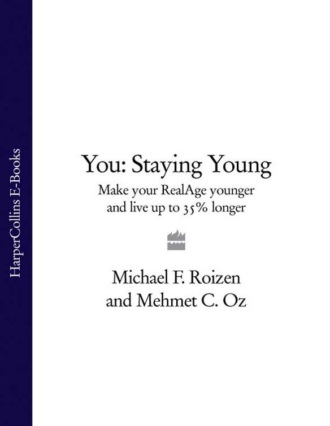
Полная версия
You: Staying Young: Make Your RealAge Younger and Live Up to 35% Longer

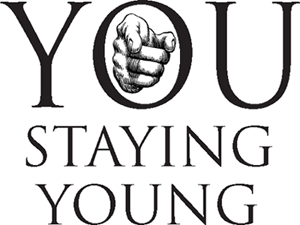
Make your RealAge younger and live up to 35% longer
DR MICHAEL F. ROIZEN
DR MEHMET C. OZ
With Ted Spiker, Craig Wynett, Lisa Oz and Dr Mark A. Rudberg
Illustrations by Gary Hallgren

Note to Readers
This publication contains the opinions and ideas of its authors. It is intended to provide helpful and informative material on the subjects addressed in the publication. It is sold with the understanding that the authors and publisher are not engaged in rendering medical, health or any other kind of personal professional services in the book. The reader should consult his or her medical, health or other competent professional before adopting any of the suggestions in this book or drawing inferences from it.
The authors and publisher specifically disclaim all responsibility for any liability, loss or risk, personal or otherwise, which is incurred as a consequence, directly or indirectly, of the use and application of any of the contents in this book.
Dedication
To all who desire longer life so they can serve more
Contents
Cover
Title Page
Note to Readers
Dedication
Part I: Why You Age and How You Stay Young
Introduction
MAJOR AGER Bad Genes & Short Telomeres How Genetics Influences Ageing – and You Control Your Genes
Chapter 1: Develop a Memorable Memory
MAJOR AGER Oxidation & Inefficient Mitochondria Keep the Energy Factories of Your Body Running Smoothly
Chapter 2: Take the Heat off Your Heart
MAJOR AGER Stem Cell Slowdown What You Can Learn – and Use – from Stem Cells to Keep Your Body Strong
Chapter 3: Get the Better of Stress
MAJOR AGER Declining Defences Why Bacteria and Viruses May Be Your Most Powerful Enemies
Chapter 4: Pump Up Your Vagus and Immune System
MAJOR AGER Toxins Keep Sludge from Seeping into Your Body
Chapter 5: Cancel Out Cancer
Chapter 6: Breathe Easy
MAJOR AGER Glycosylation How Excess Glucose Can Age You
Chapter 7: Don’t Be Pickled by Diabetes
MAJOR AGER Calorie Consumption & Slowing Sirtuin Understand the Ultimate Anti-Agers
Chapter 8: Get Great Guts
MAJOR AGER Neurotransmitter Imbalance How the Chemical Message System in Your Brain Can Age You
Chapter 9: Sleep Your Way to the Top
MAJOR AGER Wacky Hormones The Natural Fluctuations in Hormonal Levels Aren’t All Bad
Chapter 10: Make the Most of Menopause
Chapter 11: Protect Your Privates
MAJOR AGER No Nitric Oxide How Your Levels of This Gas Can Change Your Health
Chapter 12: Live the Sexy Life
MAJOR AGER UV Radiation How the Sun Can Nourish or Destroy Your Body
Chapter 13: See the World
MAJOR AGER Disuse Atrophy Prime the Pump to Keep the Body Working Well
Chapter 14: Muscle Up Your Bones
MAJOR AGER Wear & Tear How Your Body Handles the Breaking-down Process
Chapter 15: Hear Ye, Hear Ye
MAJOR AGER Unforced Errors Why Our Bodies Can’t Withstand the Crazy Things That Happen in Life
Part II: The YOU Extended Warranty Plan
Chapter 16: The Fourteen-Day YOU Extended Warranty Plan
Chapter 17: The YOU Toolbox
Chapter 18: YOU Getting Stronger
Acknowledgements
Index
About the Author
Also by the Authors
Copyright
About the Publisher
Introduction
Most of us think ageing happens like this: we go on our way, living happily through life, until one day we start to feel old, and the symptoms domino right before our cataract-clouded eyes. Our bones creak, our backs hurt, we go blank when trying to think of our neighbours’ names, we hate driving at night, we can’t play golf any more, we can’t hear what our spouses are saying, and our sex lives pretty much come down to brushing up against the washing machine. Soon we’re eating dinner at three-thirty and our primary goal of the day is staying awake long enough to catch Countdown.
To us, that approach means you’re drowning in life – not bathing in the beauty of it. We’re here to challenge that perception of ageing and create a new way of thinking about “anti-ageing medicine”. The traditional focus of the medical community has been on treating chronic diseases and reversing acute illnesses associated with ageing – cancer, heart disease, stroke. The assumption was clear: since heart disease and cancer alone account for over 50 percent of all deaths, you could live maybe 50 percent longer if you could avoid the big killers. As it turns out, this isn’t what would happen. As devastating as these diseases are, wiping them out as your killer increases your average life expectancy by only about nine and a half years – not the thirty to forty years that you would expect. Why? Because something else takes their place.
To add serious years to your life – and life to your years – you have to lower your risk for all diseases. And the only way to do that is to slow your rate of ageing on the cellular level. Curing cancer or any other disease does not necessarily do anything to change the nature or speed of your bodily ageing process. That’s because ageing and disease – although they interact with each other – aren’t the same thing. As we grow older, all of our systems slowly deteriorate, which makes us more vulnerable to disease. By slowing the ageing of our cells while simultaneously preventing disease, we can enjoy not only a higher quality of life but a much longer one as well. This is where we’re taking YOU.
What Is Your RealAge?
Throughout the book, we’ll refer to your RealAge – that is, a formula designed to figure out your biological age based on your lifestyle and behaviours, rather than your simple calendar age. Do good things, and your RealAge is much younger than your calendar age. Do bad things, and you can have the body of an oldster even if the calendar tells you that you haven’t hit thirty yet. One of the great things that the RealAge formula has taught us is this: Make changes, see the rewards. You can figure out your RealAge with a free test at – www.realage.com.
Of course, the reason why ageing is so intimidating isn’t because it appears to sneak up on you like a first-rate mugger. In reality, ageing is more like a savvy bank robber who’s spent months casing the joint. Why the discrepancy? Because there are huge delays between the cause of the problem and the effects you actually see in your life. And that means you have to start building defences in your thirties, forties and fifties against attacks that may not occur until your sixties, seventies and eighties.
Fortunately, science has finally figured out most of the spectacular biological processes that control ageing. And by learning about such things as mitochondria, telomeres, sirtuin, nitric oxide and the vagus nerve – which you will do in this book – you’ll appreciate how to apply these remarkable discoveries to your own life. As we take you inside your own body, you’ll learn about the shoelacelike chromosome that affects memory loss. You’ll discover the body’s cellular energy factories that play a role in damaging and preserving your arteries (and you thought it was all due to the buttered biscuits). You’ll even figure out whether you’re a good candidate for hormone therapy as you age and understand how your third eye controls your sleeping pattern (yes, we said third). Ultimately, by understanding the science behind your body, you’ll slow your rate of ageing – to live long and strong. While science holds the keys, only you have the power to unlock your potential longevity.
After all, ageing may be inevitable, but the rate of ageing is certainly not.
Your Body, Your City
Perhaps the best way to explain the dynamics of ageing is to take a look at another complex system that’s subjected to the same forces as your body: a city. Some cities remain beautiful and elegant in their old age (think of old but elegant European cities like London), while others that may not even be so old look worn down, beat up and in need of an urban ICU. Every city experiences the ups and downs of ageing; how well the city managers and residents adapt largely determines whether the city will age gracefully or end up on the wrong side of spray paint, riots and urban decay (see Figure Intro 1).
Now, every city has its own genetic code, just as you have yours. For a city, genes are geography – whether it’s built on a river, or whether it’s located in a hot or cold climate, or whether it lies directly in a prevalent hurricane path. The city’s geography can’t inherently change. But the city can adapt to that environment, with earthquake-proof construction, underground tunnels for walking in winter-time, or a ferry system for commuting. The adaptation the city makes to survive and to thrive is what’s crucial to its vitality. The same goes for YOU.
Just because you’ve been dealt a genetic hand that predisposes you to heart disease or diabetes or needing trousers as large as a parachute doesn’t mean that you can’t mitigate the effects of those genes. One of the major things we’ll teach you is that while you can’t change your genes, you can change whether they are turned on or off, or how you express them. Not every aggressive detrimental gene needs to be turned on, and not all of your sleepy protective genes have to remain dormant. Just like a city, you can compensate elegantly if you understand your options. After all, Rome is called the eternal city.
While some cities can deteriorate if they’re not managed well, others can be maintained and revitalized if the right resources and investments are made available. That’s the way you, too, can live gracefully and passionately with a fundamentally older infrastructure. Throughout the book, you’ll learn many ways to manage your personal metropolis. You’ll see that your immune system is your body’s police force. Your arteries are like roads that can be clogged, blocked or worn down by years of abuse. Your brain is like the energy grid that supplies power to the entire city; it can be knocked out here and there if you let neurological branches fall on your power lines. Your skin, in many ways, is like a city’s parks and green space, contributing to the overall sense of beauty and vibrancy. Your fat? Yep, landfill.
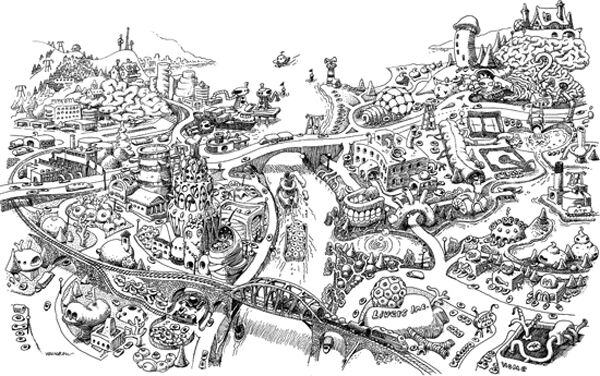
Figure Intro 1 Cityscape Every city ages in very different ways, just like your body can. This rich metaphor – the geography is like your genes, roads are like arteries, the energy grid is like your brain circuitry, the green spaces are like your skin – describes the beauty of an elegant city.
You? Consider yourself the mayor, with the power to make all the decisions about what’s best for your biological city.
Our ultimate goal isn’t just to keep your biological city from naming tumbleweed as the town flower – in other words, to keep you from dying (though that is a biggie). Our goal is to put your body at the top of the “ten best cities to live in” list. It’s to make it vibrant and hip, with lots of resources and good management of those resources. Perhaps most of all, it’s to give it the ability to adjust rapidly to changing times – to reinvent itself.
How will you get to know your city and all of the things that influence it? Here’s how we’re going to introduce it to you: science has pointed to fourteen major processes that drive almost all of the ageing we experience. Those causes of ageing – everything from wear and tear to neurotransmitter imbalances – indicate the tools you’ll need to get at what you really want: to help your body live younger and stronger, and to have more energy than a Labrador puppy.
Throughout the book, you’ll encounter these causes of ageing in special sections titled “Major Ager”; in the chapters between, you’ll discover exactly how the Major Agers affect various parts of your body and find specific, practical suggestions about how you can counteract their effects. Understanding the reasons for ageing will give you insights into the action steps for extending your own warranty, which we unveil in the last chapter.
Along the way, look for these features to help you learn about your body:



YOU Tools
Detailed programmes that will help you live longer
Anger-Management Plan
Quit-Smoking Plan
Deep-sleep Programme
Medical Tests You Need
Ultimate Workup
Deep Breathing and Meditation
Stress Management
Vital Vitamins and Supplements
Detox Plan
The YOU2 Workout
Chi-gong Workout


YOU: The Principles of Longevity
It turns out that one of the best predictors of ageing isn’t how slowly you drive or whether or not you wear tartan trousers. It’s your own perception of how healthy you are. So indulge us for a moment and answer this question:
How healthy are you compared to other people your age?





If you selected fair or bad, you’re thirty times more likely to die in the next two years. If that’s not enough to scare the cream cake right out of your mouth, then we’re not sure what is. But we’re not in the business of trying to frighten you to make changes; we simply want you to see that you’re responsible for making your own “most livable city” list. Are you happy in your body? Do you want to live there? Where do you rank your own health? Would it top anyone’s list?
The answers to these questions provide the ultimate answer to how long and well you will live. Why? Because the truth is that you are likely to have a gut feeling about how well you’re living; about how healthy you are and about your personal weak links. Your innate feelings about your body may lead to the ultimate insight – that you may not be heading in the right direction. Luckily, science is here to help. And given what science has uncovered recently (recently, as in some of this stuff could never have been talked about ten or even five years ago), you’re going to be able to make the changes.
Before we jump into the book with explanations about these wondrous biological processes – and the specific conditions and ageing-related problems you can control – let’s explore what, in fact, science has found. Once you understand these new principles of longevity, you’ll be better equipped to shift your actions. These five principles will change the way you think about the way your body ages.
1. Ageing Is Really About Trade-offs
Despite what you think, ageing – in the traditional way that we think of it, with everything slowly and painfully shutting down – isn’t “meant to be”. It’s not an effect of life. It’s actually more of a side effect of a grander plan for humans.
A lot of people think that creaky joints, craggy nails and cranky bowels are simply part of the deal. You get to live to eighty-something; then, in exchange, you’re going to have your fair share of misery along the rest of the way. Horrible being old, eh? Hold on. Yes, there is a trade-off, but it’s not that one. If you take a look at every biological process that happens in your body, there’s an evolutionary reason why it works that way, and that reason, without fail, is to ensure the survival of the species. That is, evolution has deemed the perpetuation of your genes to be much more important than the perpetuation of your individual life. Your biological processes are designed to protect you only long enough to reproduce and to raise your young. In fact, it wasn’t until the mid–twentieth century – at least in developed countries – that human beings could expect to live much beyond their reproductive years.
Those processes that make perfect sense for reproduction may not work in your favour as you get older. That’s ageing. The systems designed to protect you until you finish reproducing (whether you’re actually reproducing is unimportant) can be maladaptive as you age. When you look at ageing through the lens of the gene, rather than the lens of the individual, it all makes much more sense. These trade-offs are what we’ll occasionally refer to as the YOU-nified theory of ageing – the fact that ageing isn’t some master plan for life but, rather, an offshoot.
2. Ageing Isn’t About Breaking Down as Much as It Is About Repair
Stuff breaks. Cars, computers and relationships all have their own breaking points. And to suggest that stuff will not break either through acute injury (a fire in a building or a torn knee ligament) or from wear and tear over time (a fifty-year-old road or an overused back) would be misleading. While it’s obviously important to keep your biological systems from breaking down, the real secret to longevity isn’t whether or not you break; it’s how well you recover and repair when you do. Our bodies, in fact, weren’t designed not to break down (legs as thick as trees may not break, but they wouldn’t be very nimble). They were designed with a great efficiency and ability to repair themselves.
As with a car, you’ll get a lot more mileage out of your body if you perform routine maintenance. Ageing is essentially a process in which your cells lose their resilience; they lose their ability to repair damage because the things you might never have heard of (until now), like mitochondria and telomeres, aren’t working the way they should. But it’s within your power to boost that resilience and keep your vehicle going an extra couple of hundred thousand miles.
3. Ageing Happens from Both the Inside Out and the Outside In
Many of us like to think that ageing is a magical process that happens deep within our bodies; that some so-called gremlins of gerontology ratchet down our cells and our systems so we grow old. You’ll learn in this book that ageing is not only about those cellular processes, but, more important, it’s how you respond, adapt to and deal with the stressors that affect you from the outside – things like sun and stress and slippery pavements. What does that mean? It means that ageing is really about the rate of ageing – specifically, how the outside and inside factors accelerate or decelerate your ageing. Here’s the big secret about ageing: your rate of ageing doubles every eight years. So, if we were able to maintain a forty-year-old’s rate of ageing for the rest of our lives, we would live past the age of one hundred and twenty and “die of old age”. While inside out and outside in both play a role – and both influence each other – your job is to try to manage both forms, so that you slow the real culprit in growing old: the rate of ageing.




